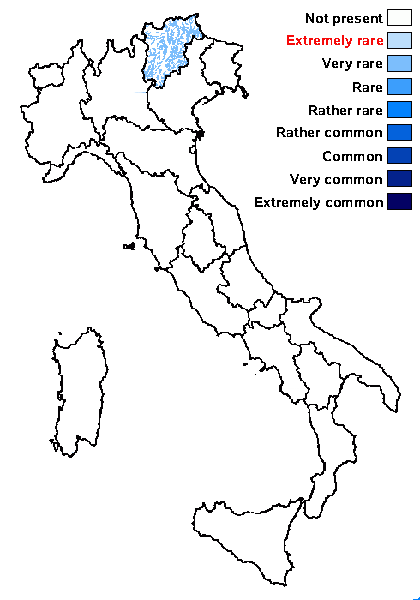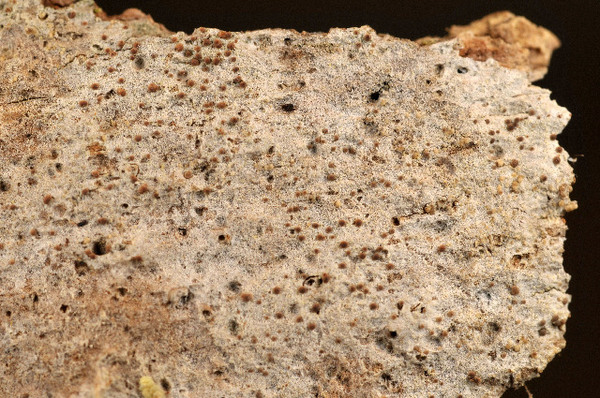Puttea caesia (Fr.) M. Svenss. & T. Sprib.
in Dillman & al., Herzogia, 25: 182, 2012. Basionym: Agyrium caesium Fr. - Syst. Mycol. (Lundae) 2, 1: 231, 1822.
Synonyms: Biatora symmictella (Nyl.) Arnold; Lecidea symmictella Nyl.
Distribution: N - TAA (Nascimbene & al. 2007b).
Description: Thallus crustose, mostly endosubstratic and poorly evident, consisting of a thin layer of delicate hyphae and small algal cells. Apothecia lecideine to biatorine, 0.1-0.2(-0.3) mm across, whitish, pale yellow or pale brown-pink, often mottled when old, more or less round, with a convex disc and a thin, dark, finally sometimes excluded proper margin. Proper exciple with an outer wall of perpendicularly arranged, parallel, gelatinized hyphae with narrow lumina, the apical cells thickened (to c. 4 µm) and often brown-capped, the inner part of gelatinized, interwoven hyphae; epithecium scarcely differentiated from the hymenium, covered with a narrow gelatinous layer overlain by yellowish crystals dissolving in K and in N; hymenium colourless, 30-40 μm high; paraphyses branched and anastomosing, as long as the asci, the apical cells hardly swollen; hypothecium colourless. Asci 8-spored, clavate, with a K/I+ blue tholus including a thin, darker K/I+ blue tubular ring-structure. Ascospores 1-celled, hyaline, ellipsoid to subfusiform, (3-)4-7(-10) x 1-2(-2.5) μm, thin-walled. Photobiont chlorococcoid. Spot tests: thallus K-, C-, KC-, P-, UV-. Chemistry: without lichen substances.Note: on hard lignum., e.g. on horizontal faces of old stumps, sometimes on mosses, mostly in upland areas. See also note on Catillaria erysiboides.
Growth form: Crustose
Substrata: lignum
Photobiont: green algae other than Trentepohlia
Reproductive strategy: mainly sexual
Poorly known taxon in need of further study
Commonnes-rarity: (info)
Alpine belt: absent
Subalpine belt: very rare
Oromediterranean belt: absent
Montane belt: very rare
Submediterranean belt: absent
Padanian area: absent
Humid submediterranean belt: absent
Humid mediterranean belt: absent
Dry mediterranean belt: absent

Predictive model
Growth form: Crustose
Substrata: lignum
Photobiont: green algae other than Trentepohlia
Reproductive strategy: mainly sexual
Poorly known taxon in need of further study
Commonnes-rarity: (info)
Alpine belt: absent
Subalpine belt: very rare
Oromediterranean belt: absent
Montane belt: very rare
Submediterranean belt: absent
Padanian area: absent
Humid submediterranean belt: absent
Humid mediterranean belt: absent
Dry mediterranean belt: absent

Predictive model
 INDEX FUNGORUM
INDEX FUNGORUM
 GBIF
GBIF
 DOLICHENS
DOLICHENS


